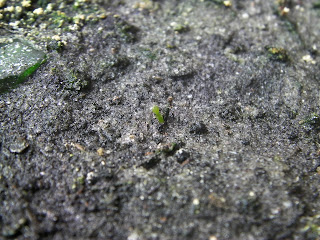 |
| Yellow Passionfruit vine eating up Travellers Palm |
So you're thinking of planting a yellow passionfruit also known as lillikoi, or Passiflora edulis var flavicarpa ?
I already had so many different tropical fruits and despreately wanted a passionfruit. I read that the purple fruited variety is very susceptable to nematodes here in South Florida's sandy soil, so I found some Brazilian yellow round passionfruit seeds. Unlike the other passionfruit seeds I had bought, thse seeds readily germinated and grew very fast.
I found 8x4x4 solid cedar posts on sale at Home Depot, bought the wire, metal connectors and all the other hardware to construct my two wire trellis as all the books and online sources instructed, only this is not near enough to support a yellow passionfruit vine.
I planted 2 containers, I had two vines, the other one. Within one year, these three plants had covered the fence, grown into my neighbour's trees, covered the whole area in the picture to a heigth off about 3 feet, started smothering my travellers palm mango, litchi, fig, papaya tree, in short, anything within its grasp.
Feeling sorry for it and hoping for some delicious fruit, I left it to its own devices. I should have followed my first instincts and gotten rid of it sooner than later. It flowered on and off but never set a single fruit.
 |
| 1 year old yellow passionfruit vine stem |
|
 |
| 4 weekends later and this area is now clear, was covered to top of fence, and rest up to 4 feet tall |
|
 |
| Some of the dead vines heaped onto a pile |
I spent the last 4 weekends getting rid of this invasive vine. Seriously, this is not something I wish on my worst enemy. To remove this vine was hell, it kept on looping aorund the head of the weed wacker and every few seconds I had to untangle it, I also used my pole pruner on it, it even managed to get into the chain saw enclosure and brought everything to a halt and I constantly had to pull the vine out to get it going again. Today I had to cut the strands with a pruner in order to untangle it from the wires and clear the area. I will not plant another passionfruit here as long as I live here. Maybe not even the tamer purple variety.
The cedar posts rotted, so much for "rot resistant cedar", guess nothing can withstand the hot, humid and wet Florida summers.
 |
| 8x4x4 cedar fence post after 1 year in ground |
If you really must plant this vine, make sure you have enough space and please do yourself a favour and keep up with it. As soon as you see it grow into your other beloved plants or trees, cut off those tendrils and keep a close watch on it, before you know it, it will completely cover everything in its path.





















































